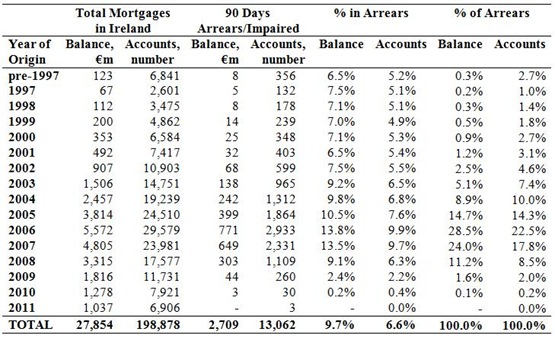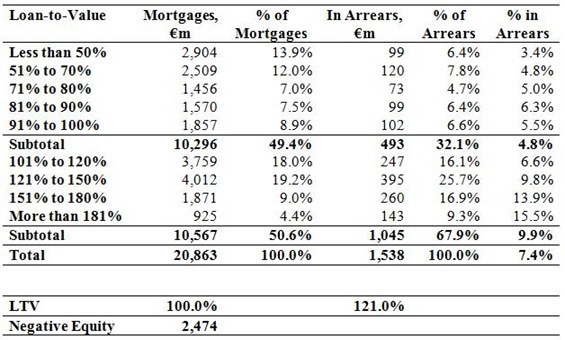The annual results for 2011 published by Bank of Ireland earlier in the week provide a interesting insight into the detail of the mortgage market in Ireland. The detail from pages 67 to 82 is something that has rarely been made available.
The Q4 2011 update of the Financial Regulator’s Mortgage Arrears Statistics showed that there was €113,477 million of owner-occupied mortgages in Ireland and that 12.3% by loan amount are in arrears of 90 days or more with 5.4% also by loan balance having been restructured in some way and not in arrears. The figure for arrears under 90 days are not provided but it is likely that somewhere close to 25% of owner-occupied mortgages by balance have experienced some difficulty.
Here are the equivalent figures for Bank of Ireland’s Irish owner-occupied mortgage book.
Bank of Ireland has 18.4% of all owner-occupied mortgages in Ireland. We can see that the levels of distress of significantly below those seen for the market as a whole. In BOI, 7.4% of mortgages by balance are in arrears of 90 days or more compared to 13.4% for all other lenders in the market.
The restructured mortgages includes mortgages which may be less than 90 days in arrears so about 85% of Bank of Ireland’s mortgages are currently being repaid according to the original terms of the mortgage. There are huge problems in the mortgage market in Ireland but BOI is still in the position of having 17 out of every 20 mortgages being repaid on time. And it is also noteworthy that the bank says that among all restructured mortgages
“98% of this balance are paying interest only or greater on their balances.
16% are paying full principal and interest having had their mortgage term extended.”
A mortgage will be in arrears if a monthly payment is partially or fully missed. A mortgage that is 90 days in arrears is the equivalent of three monthly payments in arrears, i.e. it would take the payment of a lump-sum equal to three monthly payments to bring the mortgage back on schedule.
A mortgage can be 90 days in arrears if 75% of the agreed monthly payment has been made each month for a year. The mortgage has not had a full payment made in 360 days but is the equivalent of three monthly payments or 90 days in arrears.
A mortgage will also be 90 days in arrears if three full monthly payments are missed at any stage. For example, if a mortgage had nothing paid on it between January to March 2011 and has had every monthly payment made in full since then it will be 90 days in arrears even though full payments have been made for the past year.
It is likely that there are very few mortgages on which nothing is being paid. The majority of mortgages are likely to be in arrears because only partial payments were made or a number of payments were missed in full for a period. There are likely some mortgages which are classed as being in arrears but full payments have resumed but the arrears continue to be outstanding.
The report also provides some useful insights into these figures. Of the €2,405 million of owner-occupied mortgages that in some form of arrears, €582 million are impaired and have some loss provision made against them up from €440 million at the end of 2010. Somewhat interesting is part of the explanation given for this increase in non-performing loans. At the start the report says that “this increase is primarily attributed to the general economic downturn in Ireland and affordability issues including falling disposable incomes and high unemployment levels” but then adds:
In addition to the factors mentioned above, the increase in past due and impaired since August 2011 appear to have been impacted by the implementation of the new code of conduct on arrears and the considerable public speculation about potential Government policy measures regarding customers in arrears.
Of the €1,823 million of mortgages which are more than 30 days in arrears and not impaired, Bank of Ireland estimates using initial values and subsequent CSO and ESRI house price data that €778 million of the delinquent loans have properties that are not in negative equity. This indicates that if these mortgages do default, the capacity for them to generate losses for the banks is limited as the secured collateral exceeds the size of the loan. The current trajectory of house prices suggests that this will likely deteriorate.
There is €1,045 million of non-impaired mortgages in arrears and negative equity. BOI estimate that the total negative equity on these loans is €261 million. The loan-t0-value of these loans is 133%.
BOI has €582 million of owner-occupied mortgages that are impaired and estimates that these mortgages have €171 million of negative equity. The loan-to-value of the impaired mortgages is 142%.
If all the €1,627 million of the owner-occupied mortgages which are impaired or both in arrears and negative equity were defaulted on then BOI estimates that the value of the properties secured against those loans would leave a shortfall of €432 million. With costs and other issues it is likely that BOI would be looking at a loss of around €500 million if all mortgages currently in danger were to default.
As it is BOI has made a provision of €489 million against its owner-occupied mortgage book in Ireland. This seems appropriate given the current level of arrears, impairments and house prices. With most of these measures set to deteriorate it is likely that this provision, and subsequent actual losses, will increase.
The banking stress tests from last March provided for €2,075 million of lifetime loan losses on BOI’s owner-occupied mortgage book in Ireland under the stress scenario with €1,115 million of those projected to occur in the three-years from 2011-2013.
The annual report does not tell us the level of actual losses BOI incurred on its owner-occupied mortgage book in 2011. Bank of Ireland has a policy of no debt write downs for mortgage holders.
During 2011, BOI repossessed 90 owner-occupied homes. The number of owner-occupied homes on its balance sheet increased from 65 to 99 during the year (up 34) and there was 56 disposals of repossessed owner-occupied homes during the year. It is not clear what level of shortfall was left on these repossession (an average shortfall of €200,000 would leave a total of €18 million) or if the borrower is still liable for the shortfall.
It is pretty clear that the level of owner-occupied mortgage losses in BOI is still significantly below the levels allowed for in the stress tests. This will change as the 12 month moratorium for borrowers in the Mortgage Arrears Resolution Process will end in many cases but it could be 2013 until the measures in the Draft Personal Insolvency Bill become active.
The report also gives an insight into the origination of the loans in BOI’s mortgage book. This table includes the €21 billion of owner-occupied mortgages and some €7 billion of buy-to-let mortgages. Click to enlarge.
Although mortgage arrears are clearly concentrated in loans that were issued between 2004 and 2008, there is arrears right across the loan book. This means that the increase in Mortgage Interest Relief did not benefit all those who have fallen into arrears. At a minimum around 27% of BOI’s mortgage accounts which are in arrears will not benefit from the increase in MIR as they did not originate between 2004 and 2008.
The measure also excludes non-first-time buyers from between 2004 and 2008 so it is likely that only a fraction of BOI’s mortgage arrears accounts will benefit from the increased MIR. It is also likely that many of those who gained were not in arrears and are now benefitting from increased interest relief and lower interest rates.
We also get an insight into negative equity and arrears by equity from this table.
In total, the loan-to-value of BOI’s owner-occupied loan book is estimated to be a rather convenient looking 100%. The negative equity of the €10,567 million of loans with LTVs of greater than 100% is estimated to be €2,474 million. The aggregate loan-to-value of the loans in negative equity is 131%. On the other hand the aggregate loan-to-value of loans not in negative equity is 81%. The final columns give the spread of arrears and impairment across the different LTVs.
Unsurprisingly, arrears and impairment are more likely amongst those loans that are in negative equity though almost one-third of those in arrears are not in negative equity. The portion of the loan book that has a loan-to-value of more than 181% has arrears of 15.5% by loan balance compared to just 4.8% for all loans which are not in negative equity.
If the €2,474 million of negative equity on mortgages in BOI’s owner-occupied Irish mortgage book is representative of the overall market then, being 18.4% of the total market, this would imply that the level of negative equity in the residential mortgage market is around €13,500 million. As BOI’s loan book is better performing than the rest of the market, and also has loans from before 2002 that newer entrants to the market do not have, this is likely to be an estimate from the lower range.
Tweet





Seamus
ReplyDeleteExcellent detailed analysis.
Very surprised that the arrears accounts go right back to mortgages originating in 1997. and that 21% of mortgages originating pre 2002 are in arrears.
This should have implications for recent and future tax policy changes. It is clear that lower paid and unemployed are simply not able to both continue to make ends meet and pay mortgages.
Any further impositions on these groups will clearly catch more people in this ugly net.
Hi Joseph,
ReplyDeleteThese are very detailed numbers and give a useful insight. It is interesting that the arrears are spread right throughout the loan book. I don't think 21% of mortgages from pre-2002 are in arrears though!
1,656 of the 31,780 of mortgage accounts from pre-2002 are in arrears (5.2%). These are 12.7% of the total number of accounts that are in arrears so you are right to imply that arrears is not just a phenomenon among recent mortgages.
One thing we have been missing is a 'normal' level of mortgage arrears in a functioning market. The current level of very very high but it would be nice to know how much higher it is.
Seamus
ReplyDeleteOops! Thanks. I should be more careful when looking at the data! The ~21% is the total mortgages pre 2002, I think!
Still a figure of 12.7% of pre 2002 in arrears is worrying. However it should be noted many people with what was considered substantial equity topped up their mortgages in order to get capital for buy to let both at home and abroad.
Would a mortgage originating say in 1994 but topped up in 2004, still have an origination date of 1994 in the statistics or would it have a 2004 designation?
Hey, check it out. BoI has almost €5bn in but to let loans with an LTV over 100%.
ReplyDeleteMaybe Morgan Kelly's claim of 10,000 people with over a million in loans was right after all.